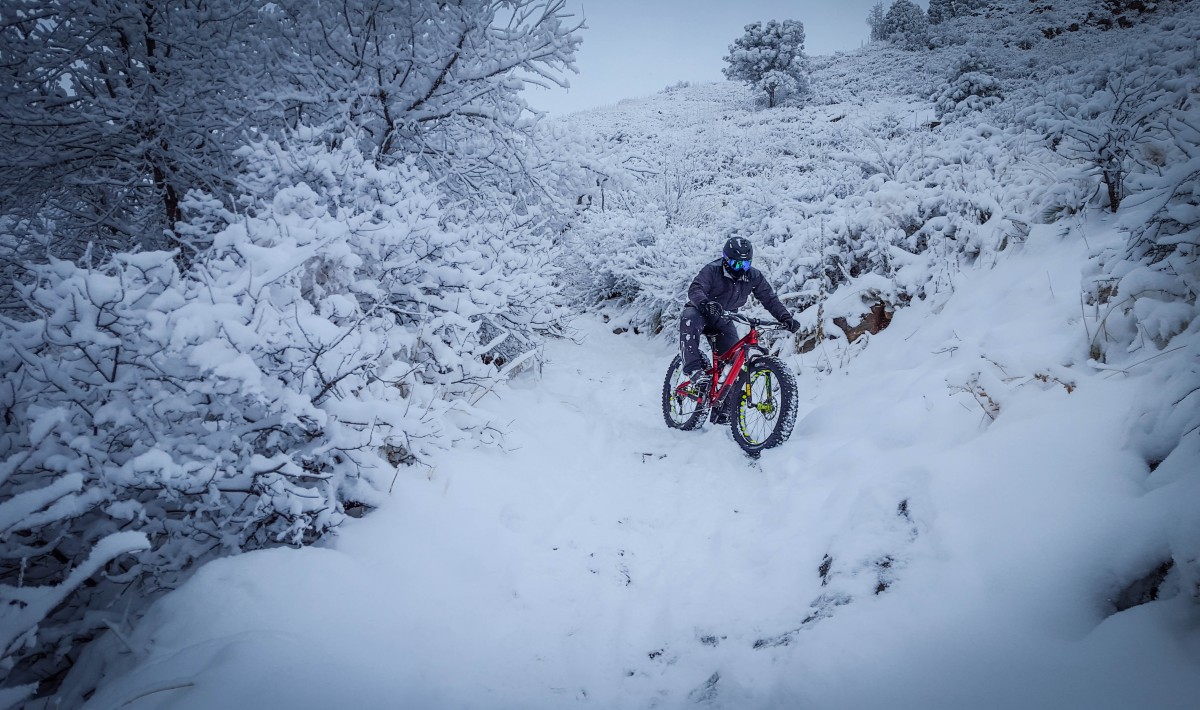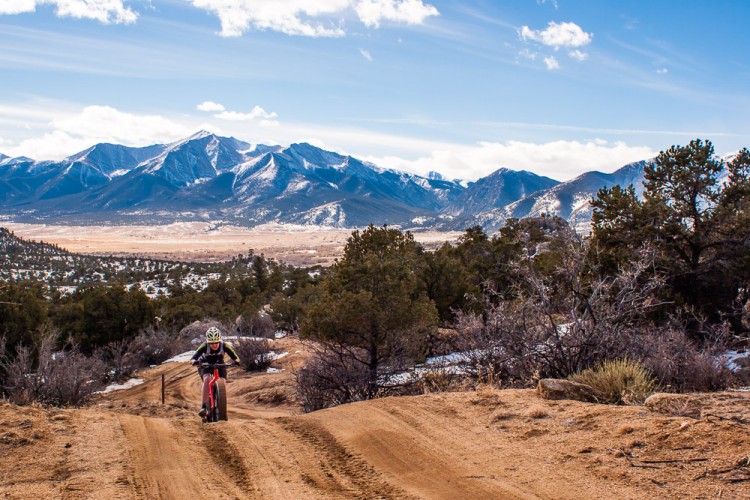I never really imagined myself on a full-suspension fatbike. My very first fatty a few years ago was a black Surly Pug Ops, a capable but beefy steed weighing in around 38 lbs. I sold that bike to purchase the first aluminum Salsa Beargrease, then sold that once I fell in love with the carbon version launched in 2014. I loved riding my 24lb rigid carbon Beargrease, but when I stuck a RockShox Bluto on it, things were never the same again.
I have a knack for breaking bikes–specifically carbon frames–so after only a year of riding my beloved carbon Beargrease, my mechanic astutely discovered a crack in the top tube. Somewhat devastated, I felt it was time to try the Salsa Bucksaw, a full-suspension all-mountain, monster-truck, ripping machine. I had two concerns since I did not have the opportunity to test ride one before I purchased and built one up. First, how much would this beast weigh, and secondly, would the extra suspension really do anything except make the rear end bob too much on climbs?

The Build
Because I swapped parts from my former fatty, my build is not exactly stock. The drivetrain is full SRAM XX1, with a 50mm stem and Easton Haven 35 bars. The first generation Bluto is set to the factory-recommended 100mm (anything more than that technically voids the warranty) of travel, and was originally mated to a Surly Rolling Darryl wheelset with with 45NRTH Flowbeist and Dunderbeist, both 4.6 (yes, they fit). The brakes are SRAM Guide RSC, and I elected to try a Thomson 125mm Covert dropper post, routed internally.
[see_also id=”198079″][/see_also]

Geometry
I’ve tested bikes from most major fat bike brands, and I cannot believe how great the Bucksaw feels! In fact, every time I hop on mine it just feels “perfect,” and I’ve had zero hesitation about taking this measly 100mm-travel bike down the same steep, gnarly stuff as my 160mm Pivot Mach 6. The 67.7-degree head angle, combined with the 100mm fork and fat, squishy tires strikes an incredible balance with deft steering and confidence when things get lively. Short 444mm chainstays make manuals and popping over obstacles a snap, and I’ve had very few pedal strikes with the 26.2mm BB drop.
For more info, you can check out the geometry chart here.

Suspension
The Rockshox Bluto has garnered numerous positive reviews, and the latest iteration with the RTC3 damper is amazing. I’m running the first gen Bluto on the Bucksaw, and so far it has yet to disappoint, although it takes a lot more time and effort to get it dialed in than other forks I’ve tested.
The 100mm Monarch shock has been amazing, and honestly, very simple to use. There is a semi-lockout that firms up the rear, which really helps with climbing, and a “rabbit” and “turtle” setting for fast or slow rebound damping, respectively. That’s it. Once you set the correct sag, the shock works with the bike to make it happen.
Aside from just having suspension on a fatty, this suspension impresses me more than I can express in words. As soon as I hop on the bike, it has this wonderful squishy feeling from the tires that is further damped by the now-dialed-in fork and shock, and it just feels amazing. It almost feels too plush, but once you start climbing, the Bucksaw uses the tires and suspension to track terrain and increase traction even more than a hardtail fatty, without sacrificing much in the way of efficiency. It’s incredible.
I will note that you must run about 8-10psi of pressure in these tires to make that happen. If you air down to ride in deep pow, there is too much tire squish and you don’t get the correct damping from the fork/shock. The only time this really affects the bike is when you are trying to break trail in soft snow and need to run the tires at 3-5psi, and in that case, I lock out the suspension anyways and use it as true fat bike.
Side note: The Salsa Bucksaw was actually not designed to be a snow bike, and a rep once told me you’ll never see a promo photo of it in the snow (true, I looked)… but it will rip through any terrain, any time of year.

Wheels/Tires
The stock Bucksaw actually comes with lustworthy Whisky 70mm carbon rims mated to Salsa hubs, and ultra-light Schwalbe Jumbo Jim 4.0 tires, which are only 1100g (that’s what my 27.5 Minions weigh!). My original build had my old Surly Rolling Darryl rims with heavier 45NRTH Flowbeist/Dunderbeists on them, but I quickly purchased the Whisky set and tried out the Jumbo Jims… more on that below.

Impressions
My first ride was at Lair O’ the Bear, an intermediate trail with a decent mix of climbing, good dirt, and some technical sections. I was a little out of shape, but could not believe how hard it was to pedal this bike uphill. In fact, about halfway up the second climb, I started to regret buying this bike without testing it, and longed for my old 24lb Beargrease.
The flipside of that ride is that I blew my PR on the descent out of the water, crushing my previous time set on my Mach 6, despite wet areas, snow, ice, and slowing for a few hikers.
I went home and scratched my head, trying to figure that out. After a few rides, changing the tire pressure, and dialing in the suspension, the climbing improved considerably. In the meantime, I had also talked myself into splurging on those fancy Whisky wheels and light Jumbo Jims.

What happened next changed the way I will henceforth view riding fat bikes. That tire and wheel combo makes the Bucksaw accelerate like a Ferrari, relative to previous bikes I’ve tried. Here, this 30lb bike, felt like a 20lb XC racer when I started pedaling, and I zoomed up the trails with ease. I could not believe it… it pedaled as fast, or faster, than any bike I’d been on in the past. Gone was that sluggish feeling on takeoff that fat tires and fat rims usually cause. The front end felt lighter–wispy, even. The Bucksaw quickly became such a renaissance bike that I looked forward to riding it more than my Mach 6, which had me worried. But I felt justified in my lavish carbon wheel purchase, marking it one of the single best component investments I’ve ever made.

When the snow started to fall in late autumn in Colorado, I made the decision to put the 45NRTH Flowbeist and Dunderbeist tires back on because I felt that the Jumbo Jims didn’t have enough lugs to bite well in loose powder. Despite the weight penalty, which did slow me down a little on the ups, the improvement in traction was incredible in dirt, mud, and snow. It’s the equivalent of replacing your XC 2.0″ tire with a beefy 2.5″ downhill tire. I was used to the bike by this point, and having the tires slow me on the ascents was acceptable, because the traction they provided on the downhill was beyond explanation. Those big, fat, sticky lugs grab the trail and keep you glued to it like no other wheel can, and I’ve already busted a few more PRs set on longer-travel bikes.

Needless to say, I’ve ridden the Bucksaw a lot in the snow this winter, and it performed as well as any other 30+lb fat bike, with the advantage of unlocking the suspension if things get rowdy. I’ve also taken it to Dakota Ridge several times. one of the most technical stretches of trail in Colorado, littered with off-camber chunky rocks, boulders, and drops. The Bucksaw with the Flow/Dunderbeists gobbled all that up like it was nothing, and hit all the jumps and drops with confidence.
In fact, I rode Dakota Ridge one day on the Bucksaw and laughed a little when my buddy was sliding around on his Santa Cruz Nomad because of damp dirt. Then, I repeated the same route the following day on my Mach 6 and almost ate it–the Mach 6 just didn’t have the same traction or bite that the Bucksaw did in the wet. Karma.

One caveat to riding a bike like the Bucksaw, though: on a very technical trail it’s like wrestling a cow out of a barn. By that I mean, it will work your body pretty hard, because you have to use a lot of your upper body and core to move that bike up, over, and around obstacles that are easier on a lighter bike. Because of that, riding the Bucksaw on rocky terrain may not be for everyone, but if you have the strength, and learn to finesse it the way you should be riding every bike, it will reward you. I suspect that it would be far easier if I slap the Jumbo Jim 4.0s back on the Whisky wheels, but I’m fairly confident that Dakota Ridge would eat those tires in just a few minutes… and they ain’t cheap.

I should also mention that it is a quiet bike, and well-designed. The frame is fully carbon except for the lower chainstays and part of the linkages, which I actually think is a good thing since they are in a position to take a lot of damage if you crash. The stays are designed to fit 4.0 tires, but as I mentioned, the 4.6 tires fit well and I had 2mm to spare on the rear chainline.
I give it a Greg Heil calf-bang factor of 0/10… I’ve never hit my calves on this bike.

I’ve often thought about what I don’t like about the Bucksaw, and I honestly have no major gripes. I do wish Salsa would allow a 120mm fork without voiding the warranty, but I’m sure they have their reasons. That said, there’s absolutely nothing I would change about this bike. I will reiterate this, though: it requires a lot more effort to ride it on technical terrain compared to a lightweight trail/AM bike. You have to use your body english more, push more torque, and really calculate take offs and landings. It is a very unforgiving bike in the air due to the heavy rotational mass of the wheels. But… that challenge is part of what makes it fun.
I’ve had a lot of fellow fat bike riders stop to admire and ask questions about the Bucksaw, and it generates a lot of interest when I post photos on social media. The fact is, it is the very definition of a “Swiss army knife” bike, and has the paint to match. You can swap out the fat tires for 27.5+, 29, or 29+ for different riding conditions or seasons, which transforms it into an entirely different bike.
Salsa hit a home run with the Bucksaw in general, and the carbon version makes it even sweeter. If you have been thinking of upgrading your bike to a Bucksaw, I don’t think you would be disappointed.
MSRP: $6,499 for X01 build and Whisky Carbon 70mm wheels
Your Turn: How about you? Have you ridden a Salsa Bucksaw? What are your impressions?





















9 Comments
Apr 18, 2016
Apr 19, 2016
Apr 18, 2016
Jan 18, 2020
Jan 25, 2019
Apr 28, 2016
Oct 28, 2016
Apr 18, 2016
Apr 18, 2016